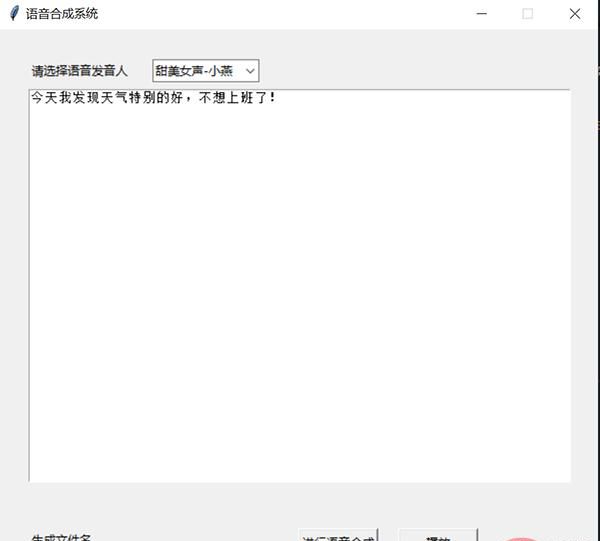利用Python打造一个语音合成系统

正文
大家好,我是Python人工智能技术
背景
一直对语音合成系统比较感兴趣,总想能给自己合成一点内容,比如说合成小说,把我下载的电子书播报给我听等等。

语音合成系统
其实就是一个基于语音合成的工具,但是这个东西由于很多厂家都提供了API的形式,因此开发难度大大降低,只需要调用几个API即可实现属于自己的语音合成工具;麻雀虽小,五脏俱全。往大了说,这就是一个小型的语音合成系统。
准备工作
首先我们电脑上需要安装
- Anaconda
- Python 3.7
- visual studio code
步骤
这里我们选用讯飞开放平台的WebAPI接口。
https://www.xfyun.cn/doc/tts/online_tts/API.html
首先我们到控制台创建一个应用

创建好了之后,点击该应用进入,有该应用的详细栏目。
点击左侧的语音合成,再到下一级在线语音合成(流式版)

在右上侧,我们需要拿到3个东西:
- APPID
- APISecret
- APIKey
代码实现
好了接下来进行代码实现了,首先安装我们需要的两个库。
pip install websocket-client pip install playsound
接下来我们定义一个类play,包含4个函数
class play: def __init__(self): #初始化函数 def play_sound(self):#播放音频函数 def select_vcn(self,*arg):#选择下拉框设置发音人 def xfyun_tts(self):#进行语音合成
在这里,大家需要填上刚才从讯飞开放平台控制台获取到的appid、appkey以及appsecret
def __init__(self):
self.APP_ID = 'xxx' #请填上自己的appid
self.API_KEY = 'xxx'#请填上自己的appkey
self.SECRET_KEY = 'xxx' #请填上自己的appsecret
self.root=tk.Tk() #初始化窗口
self.root.title("语音合成系统") #窗口名称
self.root.geometry("600x550") #设置窗口大小
self.root.resizable(0,0)
#self.root.resizable(width=True,height=True)#设置窗口是否可变,宽不可变,高可变,默认为True
self.lb=tk.Label(self.root,text='请选择语音发音人')#标签
self.tt=tk.Text(self.root,width=77,height=30) #多行文本框
self.cb=ttk.Combobox(self.root, width=12)#下拉列表框
#设置下拉列表框的内容
self.cb['values']=("甜美女声-小燕","亲切男声-许久","知性女声-小萍", "可爱童声-许小宝","亲切女声-小婧")
self.cb.current(0)#将当前选择状态置为0,也就是第一项
self.cb.bind("<<ComboboxSelected>>", self.select_vcn)
self.tk_tts_file=tk.Label(self.root,text='生成文件名')
self.b1=tk.Button(self.root, text='进行语音合成', width=10,height=1,command=self.xfyun_tts) #按钮
self.tk_play=tk.Button(self.root, text='播放', width=10,height=1,command=self.play_sound) #按钮
#各个组件的位置
self.tk_tts_file.place(x=30,y=500)
self.b1.place(x=300,y=500)
self.tk_play.place(x=400,y=500)
self.lb.place(x=30,y=30)
self.cb.place(x=154,y=30)
self.tt.place(x=30,y=60)
self.root.mainloop()当选择了下拉列表,设置对应的发音人
def select_vcn(self,*arg): if self.cb.get()=='甜美女声-小燕': self.vcn="xiaoyan" elif self.cb.get()=='亲切男声-许久': self.vcn="aisjiuxu" elif self.cb.get()=='知性女声-小萍': self.vcn="aisxping" elif self.cb.get()=='可爱童声-许小宝': self.vcn="aisbabyxu" elif self.cb.get()=='亲切女声-小婧': self.vcn="aisjinger" print(self.vcn)
接下来我们来魔改讯飞自带的Python demo为从而更加方便的来使用。另外,搜索公众号程序员小乐后台回复“赚钱”,获取一份惊喜礼包。
# -*- coding:utf-8 -*- # # author: iflytek # #本demo测试时运行的环境为:Windows + Python3.7 #本demo测试成功运行时所安装的第三方库及其版本如下: # cffi==1.12.3 # gevent==1.4.0 # greenlet==0.4.15 # pycparser==2.19 # six==1.12.0 # websocket==0.2.1 # websocket-client==0.56.0 # 合成小语种需要传输小语种文本、使用小语种发音人vcn、tte=unicode以及修改文本编码方式 #错误码链接:https://www.xfyun.cn/document/error-code (code返回错误码时必看) # # # # # # # # # # # # # # # # # # # # # # # # # # # # # # # # # # # # # # # # # # # # # # # # # # # # # # # # # # # # import websocket import datetime import hashlib import base64 import hmac import json from urllib.parse import urlencode import time import ssl from wsgiref.handlers import format_date_time from datetime import datetime from time import mktime import _thread as thread import os import wave STATUS_FIRST_FRAME = 0# 第一帧的标识 STATUS_CONTINUE_FRAME = 1# 中间帧标识 STATUS_LAST_FRAME = 2# 最后一帧的标识 PCM_PATH = "./demo.pcm" class Ws_Param(object): # 初始化 def __init__(self): pass def set_tts_params(self, text, vcn): if text != "": self.Text = text if vcn != "": self.vcn = vcn # 业务参数(business),更多个性化参数可在官网查看 self.BusinessArgs = {"bgs":1,"aue": "raw", "auf": "audio/L16;rate=16000", "vcn": self.vcn, "tte": "utf8"} #使用小语种须使用以下方式,此处的unicode指的是 utf16小端的编码方式,即"UTF-16LE"” #self.Data = {"status": 2, "text": str(base64.b64encode(self.Text.encode('utf-16')), "UTF8")} self.Data = {"status": 2, "text": str(base64.b64encode(self.Text.encode('utf-8')), "UTF8")} def set_params(self, appid, apiSecret, apiKey): if appid != "": self.APPID = appid # 公共参数(common) self.CommonArgs = {"app_id": self.APPID} if apiKey != "": self.APIKey = apiKey if apiSecret != "": self.APISecret = apiSecret # 生成url def create_url(self): url = 'wss://tts-api.xfyun.cn/v2/tts' # 生成RFC1123格式的时间戳 now = datetime.now() date = format_date_time(mktime(now.timetuple())) # 拼接字符串 signature_origin = "host: " + "ws-api.xfyun.cn" + "n" signature_origin += "date: " + date + "n" signature_origin += "GET " + "/v2/tts " + "HTTP/1.1" # 进行hmac-sha256进行加密 signature_sha = hmac.new(self.APISecret.encode('utf-8'), signature_origin.encode('utf-8'), digestmod=hashlib.sha256).digest() signature_sha = base64.b64encode(signature_sha).decode(encoding='utf-8') authorization_origin = "api_key="%s", algorithm="%s", headers="%s", signature="%s"" % ( self.APIKey, "hmac-sha256", "host date request-line", signature_sha) authorization = base64.b64encode(authorization_origin.encode('utf-8')).decode(encoding='utf-8') # 将请求的鉴权参数组合为字典 v = { "authorization": authorization, "date": date, "host": "ws-api.xfyun.cn" } url = url + '?' + urlencode(v) return url def on_message(ws, message): try: #print(message) try: message =json.loads(message) except Exception as e: print("111",e) code = message["code"] sid = message["sid"] audio = message["data"]["audio"] audio = base64.b64decode(audio) status = message["data"]["status"] print(code, sid, status) if status == 2: print("ws is closed") ws.close() if code != 0: errMsg = message["message"] print("sid:%s call error:%s code is:%s" % (sid, errMsg, code)) else: with open(PCM_PATH, 'ab') as f: f.write(audio) except Exception as e: print("receive msg,but parse exception:", e) # 收到websocket错误的处理 def on_error(ws, error): print("### error:", error) # 收到websocket关闭的处理 def on_close(ws): print("### closed ###") # 收到websocket连接建立的处理 def on_open(ws): def run(*args): d = {"common": wsParam.CommonArgs, "business": wsParam.BusinessArgs, "data": wsParam.Data, } d = json.dumps(d) print("------>开始发送文本数据") ws.send(d) if os.path.exists(PCM_PATH): os.remove(PCM_PATH) thread.start_new_thread(run, ()) def text2pcm(appid, apiSecret, apiKey, text, vcn, fname): wsParam.set_params(appid, apiSecret, apiKey) wsParam.set_tts_params(text, vcn) websocket.enableTrace(False) wsUrl = wsParam.create_url() ws = websocket.WebSocketApp(wsUrl, on_message=on_message, on_error=on_error, on_close=on_close) ws.on_open = on_open ws.run_forever(sslopt={"cert_reqs": ssl.CERT_NONE}) pcm2wav(PCM_PATH, fname) def pcm2wav(fname, dstname): with open(fname, 'rb') as pcmfile: pcmdata = pcmfile.read() print(len(pcmdata)) with wave.open(dstname, "wb") as wavfile: wavfile.setparams((1, 2, 16000, 0, 'NONE', 'NONE')) wavfile.writeframes(pcmdata) wsParam = Ws_Param()
最终一个语音合成系统就这样实现了。

当前,各种云计算、云服务迅速发展,各大公司提供了丰富的资源,大大降低了人工智能开发的门槛,不需要懂语音合成的原理,竟然可以快速开发出一个语音合成工具出来!
以上就是利用Python打造一个语音合成系统的详细内容,更多请关注其它相关文章!
